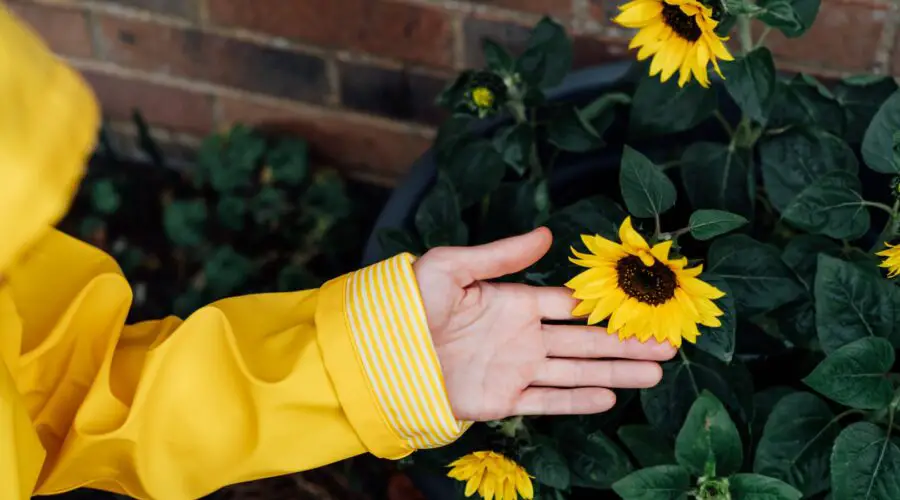How to Grow Your Own Sunflowers Indoors
Sunflowers are typically grown as outdoor plants because of their massive height and large, heavy seed heads. People often plant the iconic yellow “happy faces” to create borders or hide eyesores like fences. That doesn’t mean you can’t grow them indoors. If you are limited on yard space or want to bring a pop of color into your house, they can be grown as container plants!
Sunflower Basics
Sunflowers are a garden favorite worldwide and are loved by beginning gardeners because they are easy to grow. These flowering plants belong to the Helianthus genus and are in the same family as daisies, zinnias, marigolds, and chrysanthemums. They are iconic summer plants, bringing bright, bold color and height to your garden or flower beds.
Are Sunflowers Annual or Perennial Plants?
Surprisingly, you can buy both annual and perennial sunflowers!
Most common sunflowers—including those growing wild—are fast-growing annuals. They have one thick main stem and a sole flower head. Once they bloom, the plant dies at the end of the growing season.
Perennial sunflowers form clumps and have several main stems instead of a single one. They germinate and grow slowly and wait until the second growing season to bloom. This growth habit is because they intend to live for a longer time, so they want to establish themselves before blooming.
When Do Sunflowers Bloom?
Sunflowers are synonymous with high summer temps, as most types bloom in the midsummer to early fall. Depending on the type, they can take anywhere from 30 to 70 days after germination to begin blooming.
Once your sunflower blooms, flowers typically stay beautiful for around twenty days and then begin to fade. A longer blooming phase gives bees time to pollinate the flower and fertilize seeds.
Plants that grow a single stalk only develop one flowerhead, and won’t rebloom, even if you deadhead your plants. Branching varieties have more than one flowerhead and may bloom more than once if you remove spent blossoms.
9 Interesting Sunflower Varieties for Growing Indoors
When growing sunflowers indoors, it’s best to choose dwarf varieties. Most dwarf sunflowers grow to a maximum of two to three feet tall and never get more than five feet.
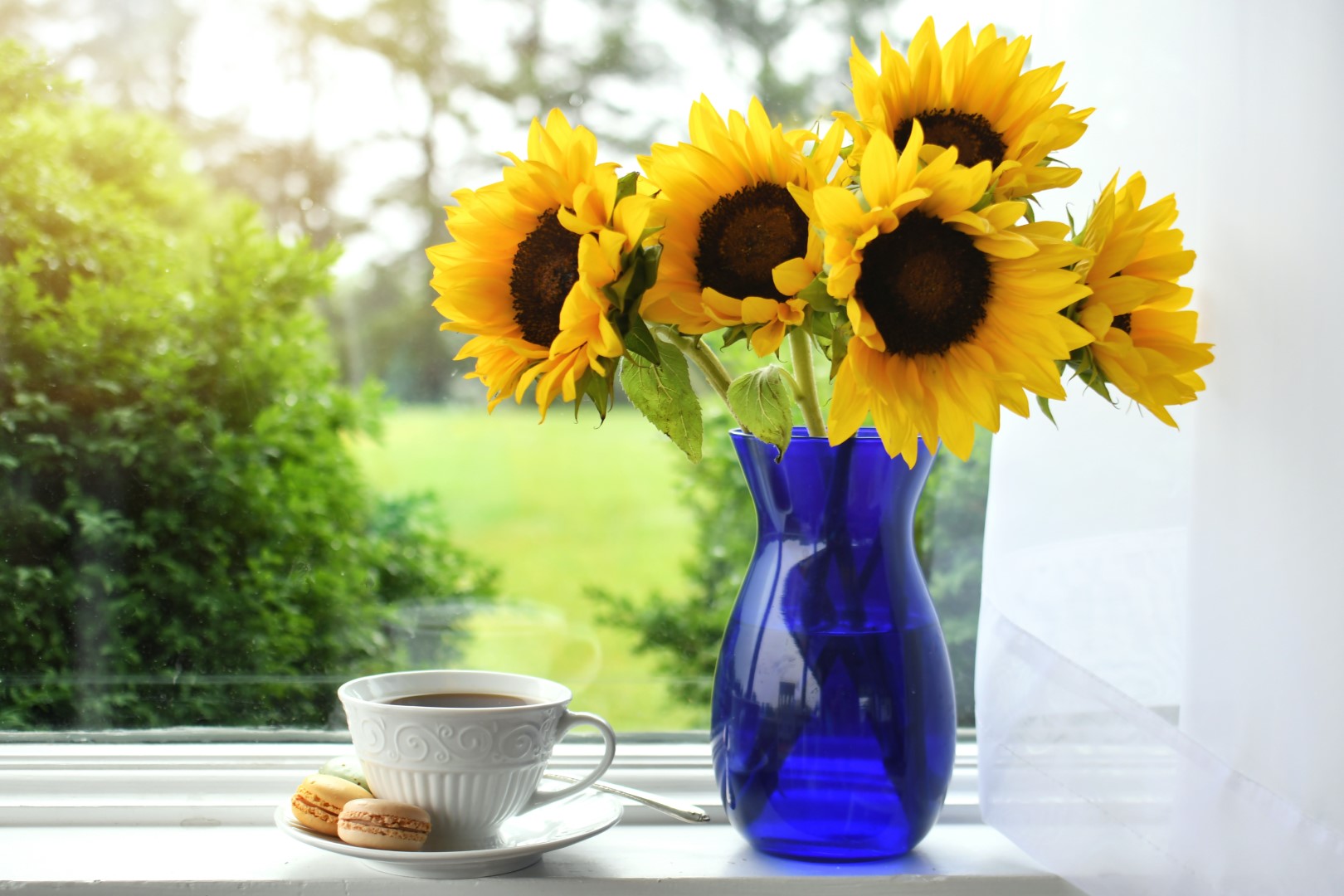
The following nine are fantastic dwarf varieties—some with the traditional sunflower look and others with unique, exciting colors or features.
- Double Dandy: (12-24” tall, 18” wide) The Double Dandy isn’t yellow like the traditional sunflower. This variety produces beautiful double-ruffled blooms with reddish to purple leaves tipped in creamy white.
- Elf: (14-16” tall, 4-6” wide) One of the shortest dwarf varieties, Elf sunflowers do well in containers with their short stature and high drought tolerance.
- Floristan: (60” tall, 18” wide) The Floristan is a taller dwarf sunflower, growing about five feet tall. Petals fade in color from reddish purple to pale yellow at the tips, surrounding a brown and yellow center disc.
- Firecracker: (36” tall, 12” wide) The Firecracker is intermediate in height, growing about three tall with a dark brown center disc surrounded by yellow and light brown petals.
- Junior: (12-24” tall, 4” wide) Junior looks identical to the common sunflower many are familiar with but only gets two feet tall, making it great for growing indoors.
- Pacino: (14” tall, 11” wide) Instead of growing a single head per stalk, Pacino is a branching sunflower type producing multiple flowers on one stem. The five-inch wide blooms have bright yellow leaves and a small, dark center disc.
- Suntastic Yellow: (12-24” tall, 8-10” wide) Suntastic Yellow is another branching type, growing multiple stems from a single stalk and numerous flowers on each stem. It grows about twenty flowers, blooming multiple times through the growing season.
- Teddy Bear: (36” tall, 18” wide) The Teddy Bear hybrid is excellent in containers, as it only grows three feet tall, but it has a characteristically unique look. Rather than the stereotypical flat petals around a center dish, it has a fluffy, soft flower.
- Yellow Pygmy: (24” tall, 6” wide) Yellow Pygymy offers growers a large flower head on a smaller, compact plant. It grows about two feet tall but holds flower heads the same size as many larger varieties.
Planting Sunflower Seeds Indoors
Gardeners wait until the threat of frost passes when planting outdoors, but growing plants inside allows you to get around the confines of weather. However, your plants will grow best during the spring, summer, and fall because of the longer day lengths. Because of this, you should sow sunflower seeds in mid to late spring to get the best growth.
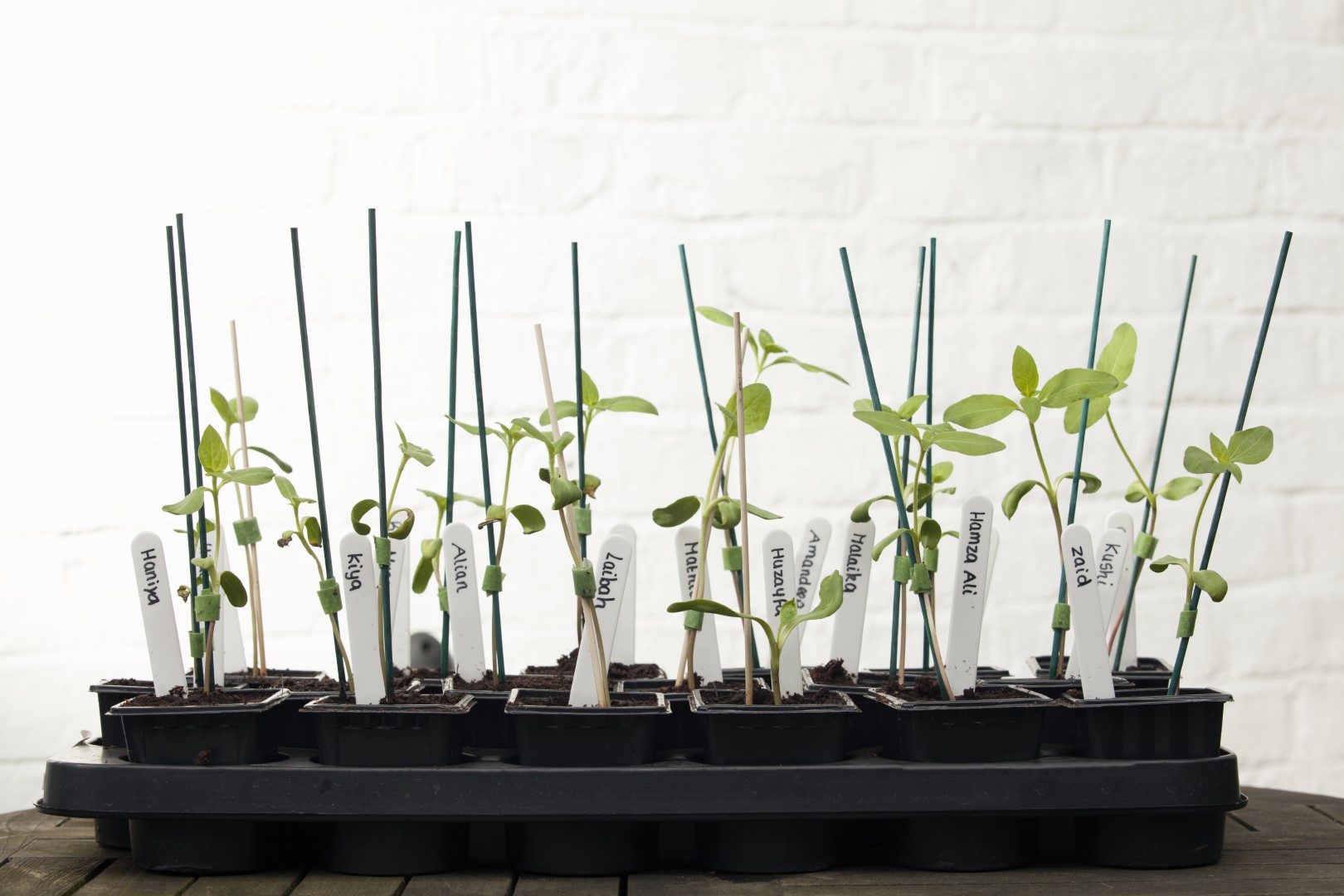
When planting:
- Opt for either coconut coir or commercial potting soil in your containers. Both are readily available online and at local retail stores. They are designed to be lighter than garden soil but hold onto nutrients and moisture while letting the excess moisture drain.
- Choose containers that are deep enough to hold your mature plants. Sunflowers don’t like their roots disturbed, so they don’t always transplant well.
- You don’t need to soak sunflower seeds before planting, but putting them in room temperature water for twelve to twenty-four hours will hasten germination time and increase the number of seeds that grow.
If soil temperatures are correct, sunflower seedlings will sprout in 10 to 14 days.
Step by Step Planting Instructions
- Fill your containers almost full with pre-moistened growing media.
- Plant two seeds per pot, about 1” deep, covering them with growing media.
- Mist with room temperature water.
- Create a mini-greenhouse by covering the container with a plastic zip-top bag.
- Set the containers in a spot where it is slightly warmer, such as on top of the fridge.
- Spritz the potting soil using a spray bottle to keep it moist.
- Remove the bag for a bit if heavy condensation collects on the inside.
- Once the seeds sprout, remove the plastic bag and put the container(s) in a spot with lots of sunlight.
Caring For Your Indoor Sunflowers
The growing conditions inside your home are slightly different than outside, and plants need different care when growing in containers versus in-ground.
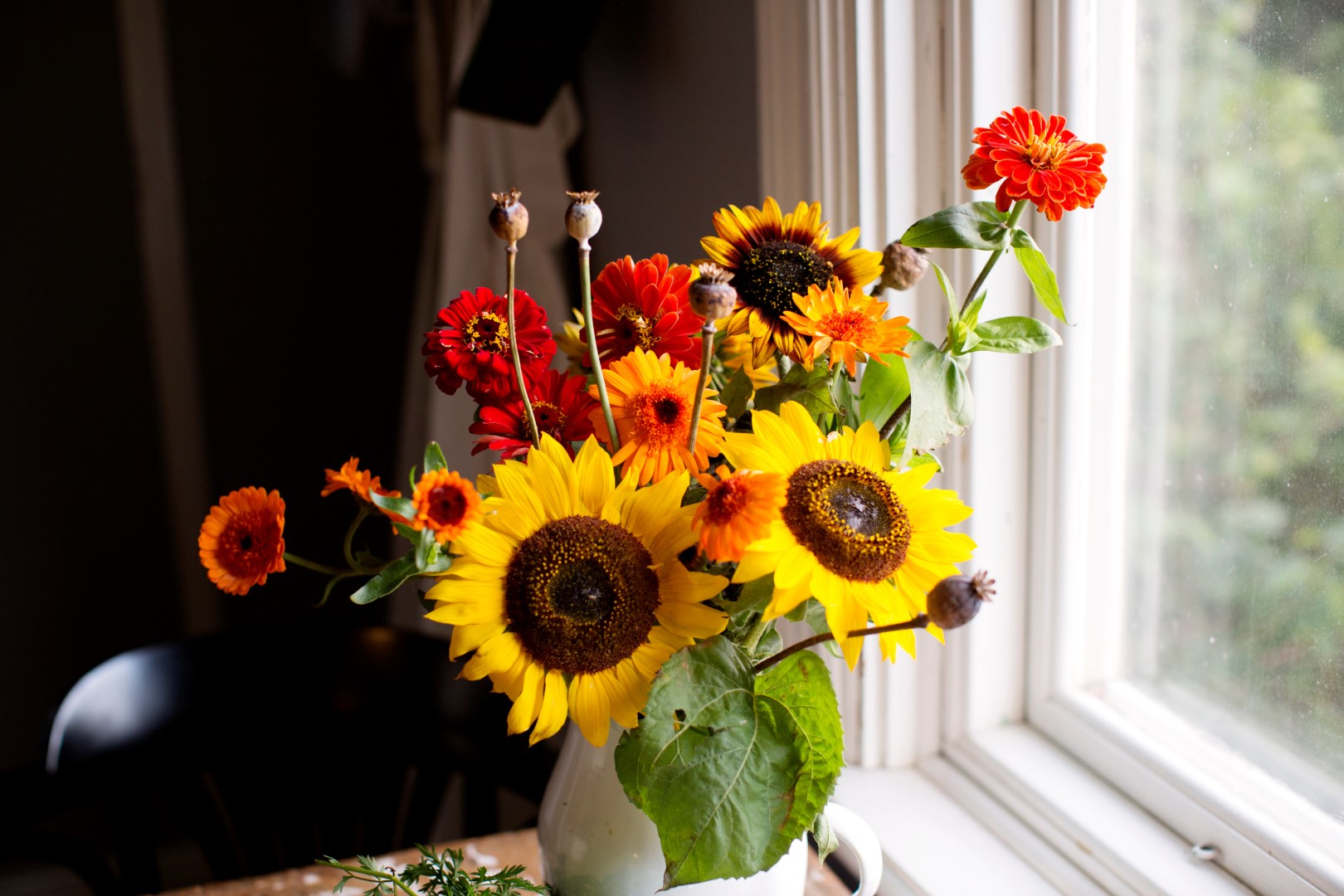
Sunlight Requirements
Indoor sunflowers thrive indoors in a spot with twelve to sixteen hours of bright sunlight. In most homes, the best places for growing them are close to windows with southern or western exposure.
- South-facing windows typically have light streaming through them most of the day, so they get the greatest amount of sun.
- West-facing windows have direct sunlight for a good part of the day and are sometimes shaded in the late afternoon, protecting plants from the intense sun.
If the light inside your home isn’t bright enough for good plant growth, you can supplement the natural light using an LED grow light. This extra light will help prevent tall, leggy plants.
Watering Needs
You want to keep the coconut coir or potting soil slightly moist at all times for 6 to 8 weeks after your seedlings sprout. To do this, put the containers in shallow water so they wick up the moisture they need. Bottom watering won’t dislodge the new seedlings and prevents overwatering.
After six to eight weeks, scale back on watering. Allow the top one inch of soil to dry before bottom watering the containers.
Fertilizer
Sunflowers are known to grow rampantly in some of the worst soils (e.g., along highways, in barren fields), so it is possible to grow them inside without giving them any fertilizer. They will, however, grow much better when fertilized regularly.
Once plants develop a second or third set of true leaves, start fertilizing them once a month using a water-soluble, balanced fertilizer.
Pruning and Deadheading
Whether or not you prune your plants depends on the type you are growing. Regardless of the type, always prune out dying, dead, or diseased leaves and stems and discard the debris.
- Annual dwarf sunflowers can be pinched back early in the season to keep plants bushy. Stop once flower buds start developing.
- Branching varieties can be pruned twice during the year to prevent uncontrolled growth. Prune them back by one-third to one-half in the spring and again in late summer to maintain a smaller, compact size.
You should deadhead spent flowers if you grow branching varieties that develop multiple branches and flower heads on a stalk. Removing them may trigger the growth of new buds. Deadheading won’t trigger fresh flowers on plants that send up a single stem with a single flower head.
Common Problems with Indoor Sunflowers
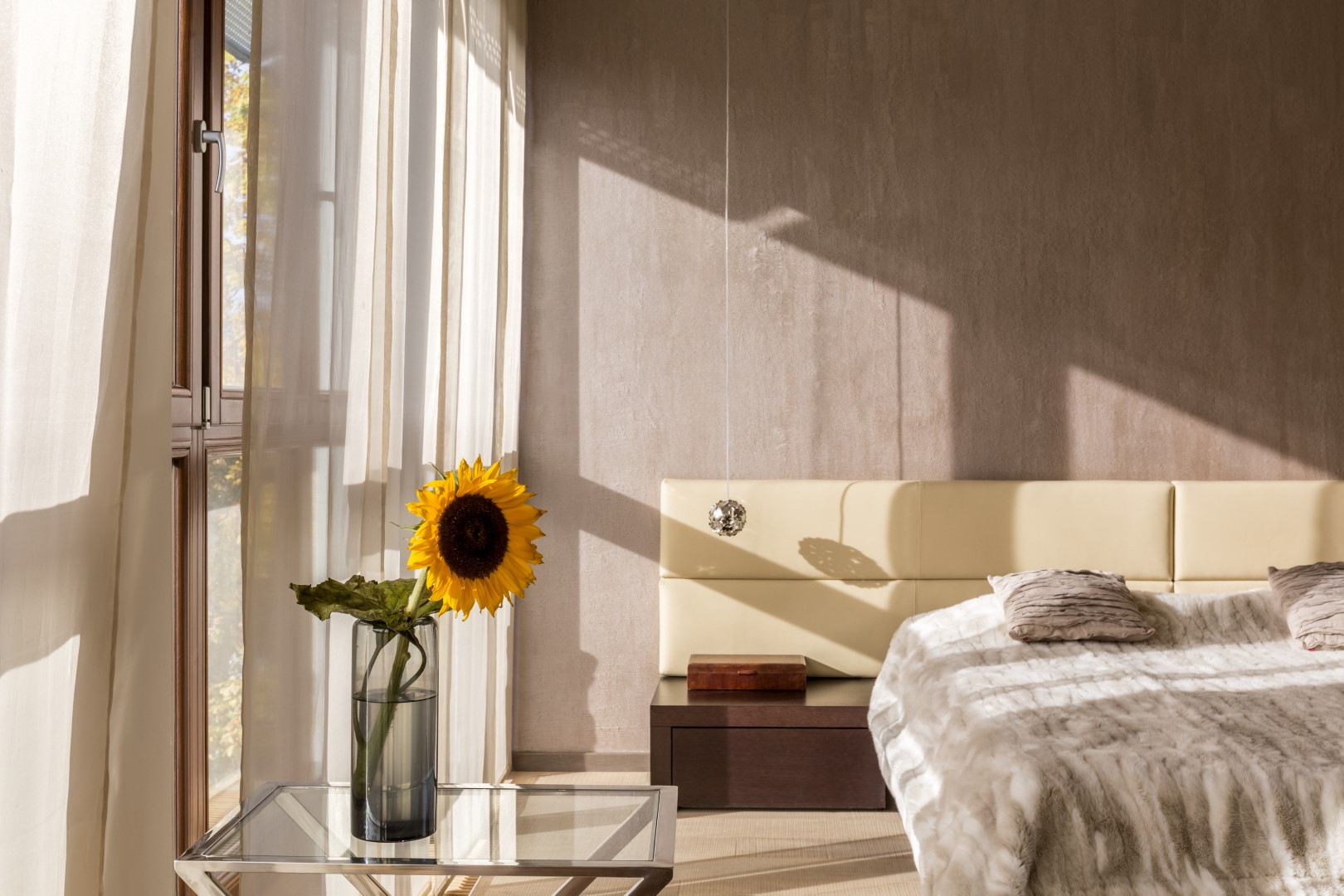
Damping Off
Damping-off occurs in seedlings and is caused by fungus or mold that thrives in cool, damp conditions. It results in seedling death. The most effective way to avoid damping-off indoors is to keep containers in a warm location, don’t overwater the potting soil, and increase air circulation by putting a small fan nearby.
Leggy Plants
You’ll see tall, spindly plants when they aren’t getting enough sun. If this happens, move them to a new spot in your house that may get more sunlight or supplement the natural light with a grow light.
Discolored Leaves
A change in leaf color typically signifies a nutrient deficiency. Reddish-purple leaves occur when there isn’t enough phosphorus in the plant, and yellow can indicate the sunflower needs nitrogen. If you’re seeding this discoloration, apply a half dose of diluted fertilizer to your plant.
Pests
Indoor plants typically have considerably fewer pest problems, but you may see problems with fungus gnats, aphids, and spider mites. To help prevent issues, increase the air circulation through the foliage and don’t overwater. Infestations can be treated naturally using neem oil or insecticidal soap.
Can You Transplant Sunflowers Outdoors?
The short answer is yes. You can transplant indoor-grown seedlings outdoors. Sunflowers don’t like their roots disturbed, though, so you may see stunting of growth after transplanting or even dieback of some of the leaves.
To increase your chances of successfully transplanting sunflowers, start acclimating them to outdoor conditions a week before you hope to move plants. Hardening off plants helps minimize transplant shock.
Dig your planting holes at the recommended spacing for your variety, and place the sunflowers, so the top of the potting soil is slightly below the soil surface. Do not break the soil around the roots before putting the plant in the hole. Then backfill with the removed soil, tamping as you go to fill any air pockets.
Are Sunflowers Toxic to Pets?
According to the American Society for the Prevention of Cruelty to Animals (ASPCA), sunflowers are listed as non-toxic. This classification means your dog or cat can eat any of the plant parts without experiencing toxicity symptoms. Veterinarians warn that eating leaves may cause minor stomach upset and vomiting.

